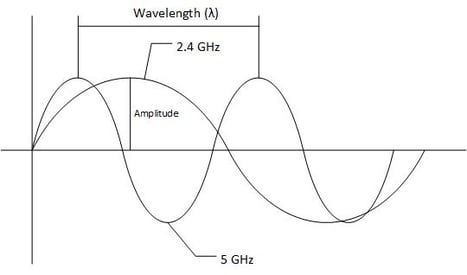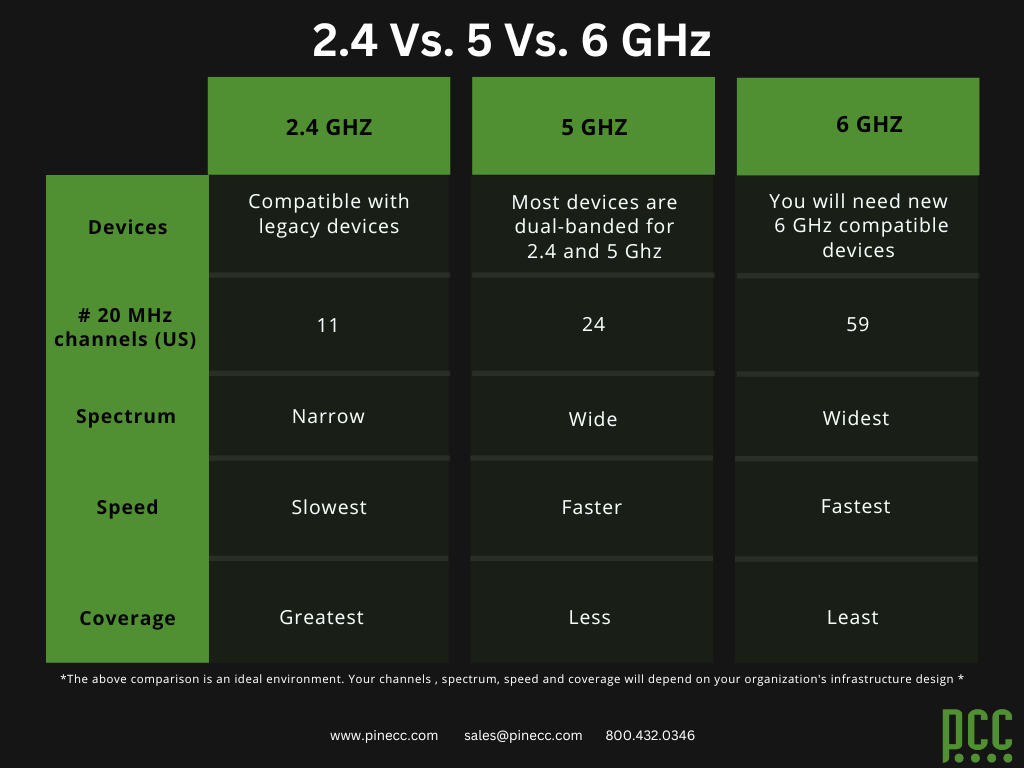Wi-Fi is a wireless technology that allows devices to connect to each other, but most importantly to the internet. While hard-wiring network devices still has a reliability advantage, many new network devices are Wi-Fi only. Radio waves carry data from an access point to a device over specific frequencies to access the internet wirelessly.
Wi-Fi operates in the 2.4, 5, and 6 GHz frequency ranges. Those three frequencies are the only unlicensed ranges available for Wi-Fi in the United States.
But what is frequency exactly?
A frequency is the number of times a wave completes a full oscillation through a fixed point in one second. The frequency affects factors such as speed, distance, and barrier penetration.
2.4 Verse 5 Ghz
2.4 is considered a legacy frequency. Even though it has been used in Wi-Fi since 1999, 2.4 is still essential in specific scenarios. Devices 10 years or older usually only work on a 2.4 GHz connection. A 2.4 GHz signal travels longer distances and easily penetrates obstacles like walls.
Compared to 2.4 GHz, 5 GHz has a much shorter range and doesn't penetrate physical barriers very well. This is due to the wave itself. During an oscillation, the particles stretch and collide to make the movement possible. The diagram below shows that 5 GHz oscillates more than two times as much as 2.4 GHz since its wavelength is much shorter. In fact, 2.4 GHz cycles 2.4 billion times, while 5 GHz 5 billion times in one second.
The more oscillations, the more the wave is affected by attenuation.
Attenuation is simply the wave losing intensity by refraction, absorption, or scattering, which results in a loss of energy and direction. When a wave loses energy and direction, it quickly becomes affected by barriers and distance. Making the data impossible to detect by the receiving device.
However, there are advantages to using 5 GHz. More spectrum is available, and there is not as much interference as in the 2.4 GHz range. Many consumer devices use 2.4 GHz, such as microwaves, baby monitors, garage openers, and Bluetooth devices. Interference causes a laggy connection.
Performance is Plummeting with 2.4 and 5 Ghz
Regardless, both 2.4 GHz and 5 GHz are suffering from device congestion. Each Wi-Fi frequency has several channels that carry data from your device to the network. When many devices use the same access point and channel, your device has to wait to send and receive signals, which results in lousy Wi-Fi performance. The uptick of Wi-Fi-capable devices in the past few years has created a congestion problem for many organizations.
Is 6 Ghz the answer?
In 2020, the FCC made 1200 MHz of spectrum in the 6 GHz band available for consumer Wi-Fi and other unlicensed uses. Opening the 6 GHz band for unlicensed use increases the amount of spectrum available for Wi-Fi by nearly a factor of five. This will help alleviate problems due to congestion on your network because many more channels are available with greater width. But more about that later.
Currently, 2.4 GHz has 11 channels available in the US, but only three do not overlap. 5 GHz has 24 non-overlapping channels. Channels can be combined to get higher speeds. When combined, fewer channels are available to assign to access points. In many organizations, you will have numerous access points throughout the buildings to compensate for all the Wi-Fi-capable devices.
Think of a highway system. There is a two-way road going between two small towns. Each lane is a channel. You travel from one city to another just as your device sends and receives a signal. Traffic is minimal, with occasional congestion in the morning and night. Then, as the cities grow, more and more cars(devices) are using the same two-lane highway. You need a roadway with more lanes and an alternative route between the two towns to offset the increased number of cars.
That's the problem 6 GHz will solve. 6 GHz will allow greater channel width (more lanes) and additional non-overlapping channels (alternative route between your device and the internet).

2.4 Vs. 5 Vs. 6 GHz
Side Note: Wi-Fi 6 only operates in the 2.4 and 5 GHz range. Wi-Fi 6E will operate in the 6 GHz range, as well as 2.4 and 5 GHz.
As you plan your network upgrade,whether 's to Wi-Fi 6 or Wi-Fi 6E, compare the three frequencies in the downloadable chart below.
Download the chart here












